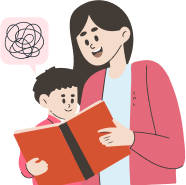Partner reading is more than just taking turns; it's a proven strategy to build fluency and boost reading confidence in children. It creates a supportive environment where readers can practice without pressure.
This blog explores how partner reading works, why it’s effective, and how FunFox applies it in real sessions. Whether you're a parent or educator, you'll find practical tips to use right away.
Key Takeaways
-
Partner reading involves two readers taking turns aloud, building fluency and confidence through shared support.
-
Techniques like echo reading, alternating sentences, and choral reading keep sessions interactive and low-pressure.
-
Partner reading creates a safe space for kids to make mistakes, self-correct, and improve without feeling judged.
-
At home, parents can use simple methods like short sessions, shared books, and positive feedback to reinforce fluency.
-
FunFox Readers Club uses structured partner reading in small groups, led by tutors who guide progress in a supportive way.
What Is Partner Reading and Why Does It Help Primary Students
Partner reading is a structured reading activity where two readers take turns reading aloud from the same text. It can be done between peers, a child and a parent, or with a tutor. While it may seem simple on the surface, it’s a highly effective technique that supports reading development in multiple ways.
At its core, partner reading helps children move away from isolated, word-by-word reading and toward fluent, expressive reading. This happens because one reader models proper pacing and phrasing, while the other follows and mirrors it. The interaction keeps students alert, engaged, and accountable, especially when both partners are involved in monitoring each other’s reading.
Partner reading is particularly powerful for students because:
-
They are still building automatic word recognition
-
They need guided support to read with correct phrasing and tone
-
Many lack the confidence to read aloud independently
By reading alongside a peer, adult, or trained tutor, the child doesn’t feel “put on the spot.” They benefit from hearing fluent reading while also getting a chance to practice in a low-pressure environment. Over time, this repeated exposure and participation build not only fluency but also confidence in their ability to decode, phrase, and express meaning.
It bridges the gap between learning to read and reading to learn, making it one of the most versatile tools in early literacy development.
How Partner Reading Works: Methods and Reader Roles Explained
Partner reading follows a structured approach that supports both fluency and comprehension. For it to be effective, each reader must have a clear role and purpose during the activity.
1. Reader and Listener Roles
In most partner reading setups, one child reads aloud while the other listens actively. After a short passage (a sentence or paragraph), they switch roles. The listener pays attention to pacing, pronunciation, and phrasing, offering gentle feedback or praise. This helps both children stay engaged and learn from one another.
2. Peer-to-Peer vs. Adult-Child Pairing
-
Peer-to-peer: Often used in classrooms, this model works well when both students are on a similar reading level. It promotes accountability and shared learning.
-
Adult-child: A parent, tutor, or older sibling takes the role of the fluent reader, modeling tone and rhythm. This is ideal for younger or less confident readers.
-
Cross-ability pairing: A stronger reader is paired with a developing reader to guide while still encouraging independence.
3. Different Modes of Partner Reading
There isn’t one fixed format. Depending on the goal (fluency, phrasing, confidence), the method can be adapted:
-
Alternating reading: One partner reads a sentence or paragraph; the other continues.
-
Echo reading: One partner reads a sentence first, then the other repeats it aloud.
-
Simultaneous reading: Both partners read together at the same pace (great for beginners).
-
Error-check reading: The listener follows along silently and flags any decoding or phrasing issues kindly after the segment.
4. Materials and Setup
Partner reading works best with printed or digital texts that both readers can view at the same time. The reading level must be appropriate for both participants. The goal isn’t speed! It’s clarity, expression, and confidence.
When used with intention, partner reading becomes a collaborative learning experience, not just a reading task. It encourages shared focus, builds oral language skills, and strengthens peer relationships, while steadily improving reading fluency.
Also read: Understanding and Teaching Text Features in Reading
How Partner Reading Helps Children Become Fluent and Confident Readers
Fluency means more than reading quickly. It involves smooth pacing, clear phrasing, and expressive reading that reflects meaning. But many children hesitate to read aloud due to fear of mistakes or lack of confidence. Partner reading helps address both fluency and confidence by turning reading into a supportive, shared experience.
Here’s how it works:
-
Children learn by listening
When a child hears someone else read, they naturally absorb how sentences should sound. They begin to notice tone, pauses, and flow, which helps them read more smoothly. -
They shift from word-by-word reading to natural phrasing
Instead of pausing at every word, children begin to group words together in a way that sounds right and makes the sentence easier to understand. -
It creates a comfortable space for reading aloud
Reading with a partner feels more relaxed than reading in front of a group. With no pressure to perform, children feel more at ease and are willing to try. -
Mistakes become learning moments
If a child misreads a word, they can correct themselves or get a gentle prompt from their partner. This kind of support helps them improve without feeling discouraged. -
It encourages re-reading without resistance
Children are more open to reading the same passage again when doing it with someone else. This extra practice naturally improves fluency. -
Struggling readers feel supported
Taking turns gives children short breaks while keeping them engaged. Listening to fluent reading and getting immediate, kind support helps them progress at a pace that suits them. -
Small improvements build lasting confidence
Every time a child reads a little more clearly or gets through a paragraph without stopping, their confidence grows. Over time, these small wins lead to stronger reading skills and greater self-assurance.
At FunFox Readers Club, we see how partner reading helps children read with clarity and speak with confidence. It gives them the tools and encouragement to become capable, engaged readers.
Proven Partner Reading Techniques to Try With Your Child
Partner reading works best when it's structured, intentional, and fun. You don’t need special tools, just a book, a quiet space, and a little bit of consistency. Here are some tried-and-true methods that make partner reading more effective (and enjoyable):
1. Echo Reading
Start by reading a sentence or a short paragraph aloud. Then, your child repeats it, trying to match your tone, pace, and pauses.
Best for: Early readers or children who need help with phrasing and rhythm.
2. Alternate Reading (Sentence or Paragraph Switch)
Take turns reading one sentence or paragraph at a time. This keeps both readers actively engaged. It also gives your child frequent chances to hear fluent reading and apply it immediately.
Best for: Children who can decode words but need help with flow and stamina.
3. Timed Repeated Reading
Choose a short passage and have your child read it aloud for one minute. Repeat the same passage daily for a few days. Track how many words they read smoothly each time.
Best for: Boosting fluency and building reading speed over time.
4. Choral Reading
Read aloud together at the same time, like a choir. This helps children who are shy or unsure of their reading voice. They gain confidence by reading with someone else’s voice guiding the way.
Best for: Building confidence and improving word recognition.
5. Error Spotting Game
Let your child follow along silently while you read aloud, but intentionally make a few minor mistakes (wrong word, skipped punctuation). Ask them to spot the errors. Then switch roles.
Best for: Building listening skills, attention to detail, and self-monitoring.
Mix and match these techniques! You don’t have to stick to just one. Start with echo reading for unfamiliar texts, then move into alternating or timed reading once your child feels more confident.
Also check out: Understanding Word Mapping in Reading
Improving Fluency and Expression Through Partner Reading in Groups
At FunFox Readers Club, partner reading isn’t a one-time activity; it’s an essential part of how fluency and confidence are built across every level. Designed for students in Grades 2 to 8, each session blends evidence-based reading strategies with personal interaction to help children grow steadily and feel good about reading.
Here’s how FunFox makes partner reading work effectively:
1. Purposeful Pairing Based on Reading Levels
Tutors group students based on their current reading ability, so partners are neither too advanced nor too behind each other. This balance ensures both children benefit: one models fluency, the other gains confidence through participation.
2. Structured Reading Routines in Every Session
Whether it’s echo reading, alternating lines, or group chorals, partner reading is built into the lesson plan, not added on casually. Tutors give clear guidance on who reads when, how feedback is given, and what to focus on each time.
3. Active Tutor Involvement Without Taking Over
Tutors listen in while partners read, offering correction when necessary but also allowing children to support each other. This balance builds independence while still keeping progress on track.
4. Support for Reluctant or Anxious Readers
Many children join the FunFox Readers Club with low reading confidence. Partner reading eases that fear by giving them a peer to lean on. They feel safer trying, knowing they’re not alone and won’t be judged.
5. Progress Monitoring That Includes Expression and Phrasing
Fluency isn’t measured by speed alone. Tutors at FunFox track improvement in pausing, tone, pacing, and phrasing, many of which improve fastest through regular partner reading practice.
By embedding partner reading into small-group instruction, FunFox ensures that every child receives the benefits of both peer modeling and guided support, which is a combination that leads to stronger, more fluent readers.
Parent-Friendly Tips to Make Partner Reading Work at Home
You don’t need to be a teacher to support your child’s reading fluency. Partner reading at home can be simple, effective, and even fun, especially when it feels like a shared activity instead of a lesson. Here’s how you can make it work in your daily routine:
-
Pick books that match your child’s reading level
Aim for texts where your child can read most words but still benefits from support with fluency and expression. -
Choose a quiet, distraction-free space
Sit side-by-side in a calm environment where both of you can clearly see the same text. -
Keep sessions short and consistent (10–15 minutes)
A daily routine is more effective than long, infrequent sessions. Short bursts help avoid fatigue. -
Use interactive reading formats.
Try alternating sentences, echo reading, or reading aloud together (choral reading). Make it feel like a team effort. -
Let your child self-correct first.
Pause briefly if they make an error. If they don’t catch it, help them sound it out and reread the sentence for fluency. -
Focus on encouragement, not perfection.
Praise effort, improvement, and expression, especially if they’ve struggled before. Confidence builds fluency. -
Avoid interrupting mid-sentence
Wait until the end of a phrase or sentence to gently correct. Too many interruptions can make your child anxious. -
Celebrate small wins out loud.
Whether they read a sentence smoothly or use a better tone, acknowledge it with simple praise like “That sounded great!” or “You read that just like a storyteller.”
Is your child scared to read out loud because of mistakes? Help them build confidence with real-time partner reading. Enroll now
Signs That Partner Reading Is Working for Your Child
Before you see big changes, fluency develops in small steps. If you're wondering whether partner reading is making a difference, here are some clear signs that show your child is gaining both skill and confidence.
-
They reread the same text more smoothly each time.
You’ll notice fewer hesitations and better flow when they revisit familiar passages. -
They start reading in phrases instead of word by word
Instead of sounding choppy, they begin to group words naturally, like how we speak in conversation. -
They pause and use punctuation cues correctly.
Commas, periods, and question marks begin to influence their tone, rhythm, and pacing. -
They make fewer decoding mistakes.
With regular practice, difficult words no longer trip them up. They decode faster and more accurately. -
They self-correct without being prompted.
If they misread something, they often go back and fix it on their own, showing growing awareness. -
They’re more willing to read aloud, even outside partner sessions
You might find them volunteering to read in class, reading to siblings, or even reading aloud to themselves for fun. -
They show more expression and confidence in their voice
Their tone becomes more natural, animated, and engaging. They are the signs they’re understanding and enjoying the story.
Wrapping up
Partner reading turns reading from a solo task into a shared experience, and that makes all the difference. When children feel supported while they read, they build fluency without fear and confidence without pressure.
At FunFox Readers Club, we use this approach every day to help children in Grades 2–8 become more expressive, capable, and motivated readers step by step.
Click here to book a free trial class and give your child the confidence to read aloud, understand deeply, and enjoy every story they open.
FAQs
1. Can partner reading support children with speech clarity or articulation issues?
Yes. Partner reading gives children repeated opportunities to hear and mimic clear speech patterns. Over time, this repeated oral practice, especially in echo or choral formats, can help improve articulation, especially when paired with targeted speech support.
2. Is partner reading useful for children who are advanced or gifted readers?
Absolutely. Gifted readers benefit from peer reading through roles like mentoring or modeling. They can take on leadership roles, practice expressive reading, or even explore character voices, deepening engagement and preventing boredom with routine tasks.
3. What if a child feels uncomfortable being corrected by a peer?
This is common in the early stages. Instead of direct correction, use techniques like rereading together or echoing the correct version subtly. It shifts the focus from “error spotting” to shared improvement, reducing sensitivity and encouraging cooperation.
4. Can partner reading be done without physical books?
Yes. Partner reading can work with digital texts, scripts, song lyrics, or even printed conversations. The key is reading aloud together. Using familiar or interest-based content (like a comic or a song) keeps the child engaged and improves fluency in a less formal setting.















